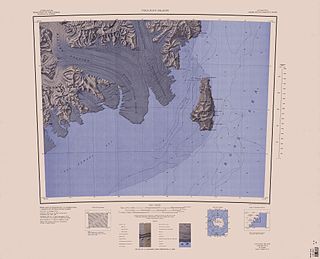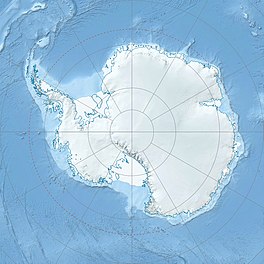
Lillie Glacier is a large glacier in Antarctica, about 100 nautical miles (190 km) long and 10 nautical miles (19 km) wide. It lies between the Bowers Mountains on the west and the Concord Mountains and Anare Mountains on the east, flowing to Ob' Bay on the coast and forming the Lillie Glacier Tongue.
Kohler Glacier is a distributary of the Smith Glacier in Marie Byrd Land, Antarctica, flowing northward through the middle of the Kohler Range into Dotson Ice Shelf. It was mapped by the U.S. Geological Survey from surveys and U.S. Navy air photos, 1959–65, and was named by the Advisory Committee on Antarctic Names in association with the Kohler Range.

Borchgrevink Glacier is a large glacier in the Victory Mountains, Victoria Land, draining south between Malta Plateau and Daniell Peninsula, and thence projecting into Glacier Strait, Ross Sea, as a floating glacier tongue, the Borchgrevink Glacier Tongue, just south of Cape Jones. It was named by the New Zealand Geological Survey Antarctic Expedition, 1957–58, for Carsten Borchgrevink, leader of the British Antarctic Expedition, 1898–1900. Borchgrevink visited the area in February 1900 and first observed the seaward portion of the glacier.
Sibelius Glacier is a glacier, 12 miles (19 km) long and 6 miles (10 km) wide, flowing south into the Mozart Ice Piedmont 10 miles (16 km) southwest of Mount Stephenson in the northern portion of Alexander Island, Antarctica. The glacier was first sighted from the air by the British Graham Land Expedition in 1937. Mapped from air photos taken by the Ronne Antarctic Research Expedition in 1947–48, by Searle of the Falkland Islands Dependencies Survey in 1960. This feature was named by the United Kingdom Antarctic Place-Names Committee for Jean Sibelius (1865-1957), Finnish composer.
Zeller Glacier is a glacier about 10 miles (16 km) long, flowing west-northwest to enter the south side of Byrd Glacier just north of Mount Fries. Named by the Advisory Committee on Antarctic Names (US-ACAN) for Edward J. Zeller, geologist at McMurdo Station, 1959–60 and 1960-61 seasons.
Haas Glacier is a steep tributary glacier draining northward from Rawson Plateau to enter the south side of Bowman Glacier, in the Queen Maud Mountains of Antarctica. It was mapped by the United States Geological Survey from surveys and U.S. Navy air photos, 1960–64, and was named by the Advisory Committee on Antarctic Names for Charles G. Haas, a meteorologist in the South Pole Station winter party, 1960.
Acosta Glacier is a glacier about 2 miles (3 km) long flowing north from Thurston Island just east of Dyer Point in Antarctica. It was named by the Advisory Committee on Antarctic Names (US-ACAN) after Alex V. Acosta of the United States Geological Survey (USGS) in Flagstaff, Arizona. He is a computer and graphic specialist, and was part of the USGS team that compiled the 1:5,000,000-scale Advanced Very High Resolution Radiometer satellite image maps of Antarctica and the 1:250,000-scale Landsat image maps of the Siple Coast area in the 1990s.
Burgess Glacier is a glacier, 7 nautical miles (13 km) long, flowing northwest through Otway Massif to enter Mill Stream Glacier. It was named by the Advisory Committee on Antarctic Names for Robert W. Burgess, a United States Antarctic Research Program ionospheric physicist at South Pole Station, 1963.

Carey Glacier is a glacier on the east side of Miller and Fruzhin Peaks and west of Ruset and Malkoch Peaks in Petvar Heights at the southeast end of the Sentinel Range, Ellsworth Mountains, flowing southeast to Minnesota Glacier. It was mapped by the United States Geological Survey from surveys and from U.S. Navy air photos, 1957–59, and named by the Advisory Committee on Antarctic Names for Lieutenant David W. Carey, pilot with U.S. Navy Squadron VX-6, who was killed in the crash of a P2V Neptune airplane at McMurdo Sound in October 1956.
Chavez Glacier is a glacier about 10 nmi long flowing south from Canisteo Peninsula into Cranton Bay. It was named by the Advisory Committee on Antarctic Names after Pat Chavez of the United States Geological Survey (USGS), Flagstaff, Arizona, co-leader of the USGS team that compiled the 1:5,000,000-scale Advanced Very High Resolution Radiometer maps of Antarctica in the 1990s.

Darbel Bay is a bay 25 nautical miles (50 km) wide, indenting the west coast of Graham Land between Stresher Peninsula and Pernik Peninsula. Entered southwest of Cape Bellue and northeast of Cape Rey. The glaciers Widmark Ice Piedmont, Cardell, Erskine, Hopkins, Drummond, Widdowson, McCance, Solun, and Škorpil feed the bay.
Gruening Glacier is a broad glacier descending southeast between steep rock walls to the northwest part of Hilton Inlet, on the east coast of Palmer Land, Antarctica. It was discovered by the United States Antarctic Service (USAS) in a flight down this glacier from East Base on December 30, 1940, and was named for Ernest H. Gruening, Director of the Division of Territories and Island Possessions, U.S. Department of the Interior, during the inception of the USAS, and a member of the Executive Committee by which the USAS was directed; later U.S. Senator from Alaska.

Edgeworth Glacier is a glacier 12 nautical miles (22 km) long, flowing south-southwestwards from the edge of Detroit Plateau below Wolseley Buttress and Paramun Buttress between Trave Peak and Chipev Nunatak into Mundraga Bay west of Sobral Peninsula, on the Nordenskjöld Coast of Graham Land. It was mapped from surveys by the Falkland Islands Dependencies Survey (1960–61), and was named by the UK Antarctic Place-Names Committee for Richard Lovell Edgeworth, the British inventor of the "portable railway," the first track-laying vehicle, in 1770.

Long Glacier is a glacier about 8 nautical miles long in the southeastern part of Thurston Island, Antarctica. It flows south to the Abbot Ice Shelf, 14 nautical miles (26 km) west of Harrison Nunatak. The glacier was mapped by the United States Geological Survey from surveys and U.S. Navy air photos, 1960–66, and was named by the Advisory Committee on Antarctic Names (US-ACAN) for Fred A. Long, Jr., an aviation machinist of U.S. Navy Squadron VX-6, who wintered at Little America V in 1957 and was in Antarctica in the 1960–61 and 1962–63 seasons.

Mincer Glacier is a broad glacier flowing from Zuhn Bluff into the southeast arm of Murphy Inlet on the north side of Thurston Island, Antarctica. It was named by the Advisory Committee on Antarctic Names after Lieutenant Dale F. Mincer, a co-pilot of PBM Mariner aircraft in the Eastern Group of U.S. Navy Operation Highjump, which obtained aerial photographs of Thurston Island and adjacent coastal areas in 1946–47.
Meinardus Glacier is an extensive glacier in Palmer Land, Antarctica. It flows in an east-northeast direction to a point immediately east of Mount Barkow, where it is joined from the northwest by Haines Glacier, and then flows east to enter New Bedford Inlet close west of Court Nunatak, on the east coast of Palmer Land. The glacier was discovered and photographed from the air in December 1940 by the United States Antarctic Service. During 1947 it was photographed from the air by the Ronne Antarctic Research Expedition under Finn Ronne, who in conjunction with the Falkland Islands Dependencies Survey (FIDS) charted it from the ground. It was named by the FIDS for Wilhelm Meinardus, a German meteorologist and climatologist and author of many publications including the meteorological results of the German Antarctic Expedition under Drygalski, 1901–03.

Hlubeck Glacier is a glacier 9 nautical miles west of Long Glacier in southeast Thurston Island, Antarctica. It flows south along the east side of Shelton Head into the Abbot Ice Shelf. The glacier was named by the Advisory Committee on Antarctic Names after aviation radioman Vernon R. Hlubeck, a PBM Mariner aircrewman in the Eastern group of U.S. Navy Operation Highjump, which obtained aerial photographs of Thurston Island and adjoining coastal areas, 1946–47.
The Hyperion Nunataks are a group of about 10 nunataks lying south of Saturn Glacier and 8 nautical miles (15 km) west of the Corner Cliffs, in the southeastern part of Alexander Island, Antarctica. The group was first seen and photographed from the air by Lincoln Ellsworth on November 23, 1935, and mapped from these photos by W.L.G. Joerg. It was surveyed in 1949 by the Falkland Islands Dependencies Survey, and so named by the United Kingdom Antarctic Place-Names Committee in association with nearby Saturn Glacier, Hyperion being one of the satellites of the planet Saturn.

McCance Glacier is the 30-km long and 5 km wide glacier draining the Hutchison Hill area on the west slopes of Avery Plateau on Loubet Coast in Graham Land, Antarctica. It flows north-northwestwards along the west side of Osikovo Ridge, Kladnitsa Peak and Rubner Peak and enters Darbel Bay.
Lerchenfeld Glacier is a glacier flowing in a west-northwesterly direction between Bertrab Nunatak and the Littlewood Nunataks in Antarctica. It coalesces with the southern flank of Schweitzer Glacier before the combined flow discharges into the head of Vahsel Bay. The glacier was discovered by the Second German Antarctic Expedition, 1911–12, under Wilhelm Filchner, who named this feature for Count Hugo von und zu Lerchenfeld-Köfering, a supporter of the expedition.







